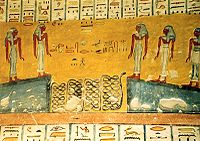Hereret
| Hereret in hieroglyphics | |||||||
|---|---|---|---|---|---|---|---|
| short |
|
||||||
| or with determinative (grave Asyut III) |
|
||||||
| or with determinative (grave Asyut IV) |
|
||||||
| or in the port book with determinative |
|
||||||
| transcription | Hereret Ḥrr.t |
||||||
| Depiction of Hereret in the 4th hour of the Book of the Portals | |||||||
Hereret is the name of female deities in Egyptian mythology . They are only mentioned or depicted in graves.
Occurrence
In the necropolis of Assiut
The goddess Hereret is mentioned twice in the tombs of the necropolis of Assiut , namely in the large inscription on the right side wall of tomb III of Jtj-jb-j and on the door jamb of tomb IV of Cheti II. In tomb III the Goddess the determinative of a jackal-headed deity. It can therefore be assumed that the goddess is a jackal- or wolf-headed goddess, who could then represent the counterpart to the dead gods Upuaut and Anubis, who were worshiped in Asyut .
In the port book
In the Book of the Portals , Hereret is represented as a serpent wound many times, “the one who removes”, in the fourth hour in the middle register . She gives birth to the snakes representing twelve hours and destroys them again. On both sides of the loft you can see two inclined platforms, each with six hours of the night.
In the description of the scene, the snake is referred to twice with its name Hereret. The name of the goddess ends with the determinative for snake.
In the Book of the Dead
Furthermore, the deity Hereret is mentioned at the entrance of the eleventh gate in the Egyptian Book of the Dead , Proverbs 145. This saying is z. B. completely written down in the Theban grave TT353 of Senenmut . The goddess is the ruler of this gate of the heart mat, for which one exults on the day of hearing the misdeeds.
Meaning of the name
The meaning of the name is controversial. The name is often given as "the terrifying one", but with a question mark. In the verse of the Book of the Dead she is called Ḥrr.t-nt-sbbtt-nbt , for which the translation "the terrifying one (?) Of every gate" is suggested.
In the German-language portal book translations, the translation is given as "the removing one" (Erik Hornung), in English-language publications it often remains untranslated.
Individual evidence
- ↑ Hellmut Brunner : The texts from the graves of the Herakleopolitenzeit von Siut. Augustin, Glückstadt / Hamburg / New York 1937, pp. 17–26, 47.
- ↑ Wolfgang Schenkel , Memphis, Herakleopolis, Thebes. Harrassowitz, Wiesbaden 1965, pp. 75-81, line 33.
- ↑ Hellmut Brunner: The texts from the graves of the Herakleopolitenzeit von Siut. Glückstadt u. a. 1937, pp. 34, 59.
- ↑ Wolfgang Schenkel: Memphis, Herakleopolis, Theben , Wiesbaden 1965, p. 85, line 54.
- ↑ Erik Hornung : The Egyptians' underworld books. Zurich / Munich 1992, ISBN 978-3760810614 , 4th hour, 20th scene, pp. 222-224.
- ^ Erik Hornung: The tomb of Pharaoh Seti I. Artemis-Verlag, Zurich a. a. 1991, ISBN 978-3760810478 , p. 217, plate 153.
- ↑ Erik Hornung: The Egyptian Book of the Dead. Zurich [u. a.] 1990, p. 287 f.
- ↑ Christian Leitz (Ed.): Lexicon of the Egyptian gods and names of gods. Volume 5, Peeters, Leuven u. a. 2002-2003, ISBN 978-9042911505 , p. 465.
- ^ EA Wallis Budge : The Egyptian Heaven and Hell. Volume 2: The short form of the book Ȧm Ṭuat and the book of gates. Kegan, Paul, Trench & Trübner, London 1906, Chapter 9, p. 140.
